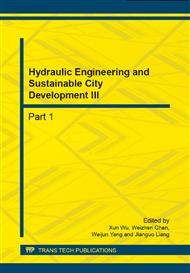[1]
A. Moran, B. Hunt, J. Smith, Hydrologic and water quality performance from greenroofs in Goldsboro and Raleigh, North Carolina, in Proc. Greening Rooftops for Sustainable Communities: Washington D.C., Washington D.C., 4-6 May (2005).
Google Scholar
[2]
D. Tillinger, G. Ostroff, D. Beattie, R. Berghage, P. Mankiewicz, F. Montaldo, Hydrologic Functions of Green Roofs in New York City. Green Roofs in the New York Metropolitan Region: Research Report, Columbia University Center for Climate Systems Research and NASA Goddard Institute for Space Studies, pp.27-36, (2006).
Google Scholar
[3]
M. Carbone, G. Garofalo, G. Nigro, P. Piro, A conceptual model for predicting hydraulic behaviour of a green roof, Procedia Engineering, pp.266-274, (2014).
DOI: 10.1016/j.proeng.2014.02.030
Google Scholar
[4]
C. Farrell, X.Q. Ang, J.P. Rayner, Water-retention additives increase plant available water in green roof substrates, Ecological Engineering, 52, pp.112-118, (2013).
DOI: 10.1016/j.ecoleng.2012.12.098
Google Scholar
[5]
N. Dunnett, N. Kingsbury, Planting Green Roofs and Living Walls, Timber Press, Portland. (2004).
Google Scholar
[6]
A. Palla, I. Gnecco, L.G. Lanza, Compared performance of a conceptual and a mechanistic hydrologic models of a green roof, in Hydrological Processes, 26 (1), pp.73-84, (2012).
DOI: 10.1002/hyp.8112
Google Scholar
[7]
R.N. Hilten, T.M. Lawrence, E.W. Tollner, Modeling stormwater runoff from green roofs with HYDRUS-1D, Journal of Hydrology, 358(3), pp.288-293, (2008).
DOI: 10.1016/j.jhydrol.2008.06.010
Google Scholar
[8]
G. Spolek, Performance monitoring of three eco-roofs in Portland, Oregon, Urban Ecosystem, 11, pp.349-359, (2008).
DOI: 10.1007/s11252-008-0061-z
Google Scholar
[9]
A. Teemusk, U. Mander, Rainwater runoff quantity and quality performance from a greenroof: The effects of short-term events, Ecological Engineering, 30, pp.271-277, (2007).
DOI: 10.1016/j.ecoleng.2007.01.009
Google Scholar
[10]
J. Mentens, D. Reas, M. Hermy, Green roofs as a tool for solving the rainwater runoff problem in the urbanized 21st century?, Landscape Urban Planning, 77 (3), pp.217-226, (2006).
DOI: 10.1016/j.landurbplan.2005.02.010
Google Scholar
[11]
U. Zimmer, W.F. Geiger, Model for the design of multi-layered infiltration systems, Water Science and Technology, 36 (8–9), pp.301-306, (1997).
DOI: 10.2166/wst.1997.0683
Google Scholar
[12]
E.L. Villarreal, A. Semadeni-Davies, L. Bengtsson, Inner city stormwater control using a combination of best management practices, Ecological Engineering, 22, pp.279-298, (2004).
DOI: 10.1016/j.ecoleng.2004.06.007
Google Scholar
[13]
T.L. Carter, C.R. Jackson, Vegetated roofs for stormwater management at multiple spatial scales, Landscape Urban Planning, 80 (1-2), pp.84-94, (2006).
DOI: 10.1016/j.landurbplan.2006.06.005
Google Scholar
[14]
D.A. Hollander, Mathematical rainfall/runoff modeling methods for green roofs and their applications, Thesis Master, (2007).
Google Scholar
[15]
A. Palla, I. Gnecco, L.G. Lanza, Unsaturated 2D modelling of subsurface water flowin the coarse-grained porous matrix of a green roof, Journal of Hydrology, 379, pp.193-204, (2009).
DOI: 10.1016/j.jhydrol.2009.10.008
Google Scholar
[16]
P. Piro, M. Carbone, A modelling approach to assessing variations of total suspended solids (TSS) mass fluxes during storm events, Hydrological Processes, 28(4), pp.2419-2426, (2014).
DOI: 10.1002/hyp.9809
Google Scholar
[17]
A.R. Lewis, Storm Water Management Model - User's Manual Version 5. 0, United States Environmental Protection Agency, Cincinnati, OH, United States (2004).
Google Scholar
[18]
K. Metselaar, Water retention and evapotranspiration of green roofs and possible natural vegetation types, Resources, Conservation and Recycling, 64, pp.49-55, (2012).
DOI: 10.1016/j.resconrec.2011.12.009
Google Scholar
[19]
B.M. Wadzuk, D. Schneider, M. Feller, R.G. Traver, Evapotranspiration from a Green Roof Stormwater Control Measure, Journal of Irrigation and Drainage Engineering, 139, pp.995-1003, (2013).
DOI: 10.1061/(asce)ir.1943-4774.0000643
Google Scholar


